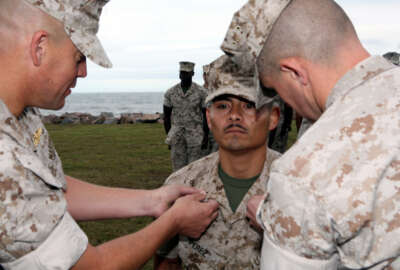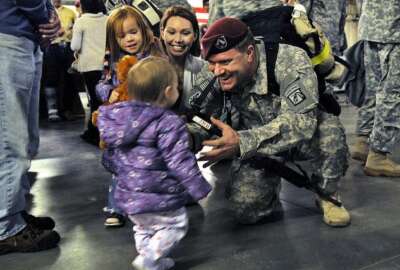
Lack of leadership in DoD’s personnel and readiness office could be detrimental, analysts say
Without any leadership appointed from the administration, the personnel and readiness office is unable to set any new policy.
Best listening experience is on Chrome, Firefox or Safari. Subscribe to Federal Drive’s daily audio interviews on Apple Podcasts or PodcastOne.
The removal of David Shulkin as Veterans Affairs Department secretary at the end of March did more than make waves in the VA. It also caused a shuffle in leadership at one of the Defense Department’s most neglected offices.
Robert Wilkie is now the acting VA secretary, but before that he barely had a chance to warm his seat as the Defense undersecretary for personnel and readiness.
Wilkie is now technically serving in both roles, but the office of personnel and readiness seems in dire straits. The office has five presidentially-appointed and Senate-confirmed leadership positions. All of those positions, except for Wilkie’s, are currently vacant or have someone performing the duties until the Trump administration appoints a person to fill the role.
That can cause some serious issues for the Defense Department, which constantly states its people are the most important assets.
“It’s critical that the administration have its people in the roles to promote their agenda,” said Todd Weiler, former assistant secretary of defense for manpower and reserve affairs under President Obama. Weiler’s former position is one of the five currently without an appointee.
Inventiveness needed to increase military
The personnel and readiness office has been neglected for years. Since 2009, nine people held the position of undersecretary or acting undersecretary.
That turnover and lack of leadership coming from people with actual political clout in the administration has serious effects on things like recruitment, health policy and readiness.
“In this particular instance its vitally important [to have leadership] because the people in these roles are going to be the ones going on to create the policies and programs that go on to increase the size of the military that president wants,” Weiler said.
He said increasing the size of the military involves inventiveness and new ideas, especially in a time when the economy is strong and companies are hiring.
“That’s something that has to be led by the political leadership,” he said. “It’s not something that can come out organically from the Pentagon.”
David Lapan, former DoD press secretary and senior director of communications for the Bipartisan Policy Center, said it is the personnel and readiness office that creates policy for recruiting, retention and training.
Andrew Swick, a research associate at the Center for a New American Security, said that outside of the administration’s planned build up, readiness issues are being neglected without leadership.
The personnel and readiness office is responsible for the “Defense Readiness Reporting System, which tracks and updates a snapshot of readiness across the services at any one point in time,” Swick said. “There’s been a lot of conversation over the past couple years as to whether the Pentagon has a readiness problem … The answer to that is we don’t know whether the Pentagon has a readiness problem because the reporting is not always accurate, and the system is not fool-proof. One of the problems with not having consistent leadership with personnel and readiness is there’s not as much oversight as you could have over readiness reporting.”
Lapan said it is not only troops who are affected by personnel and readiness issues, but also their families.
“The old saying goes ‘You recruit the individual, but you retain or reenlist the family,'” he said. “This is all the stuff the office of personnel and readiness does and if you’re only looking at the day-to-day and keeping things going, and you don’t have somebody at the top looking forward, you could end up having problems down the road of maintaining this all volunteer force.”
No clear answer for office’s neglect
So how does the personnel and readiness office operate without political leadership? Weiler described it as a metronome.
“It’s that tick, tick, tick everything is running on time, everything is running,” he said. “There’s no improvement, there’s no major adjustments. It’s just moving forward. The career leadership is really there to ensure continuity and it ensure that things progress in normal fashion and to support the political leadership in their decision making progress.”
Swick said the individual military personnel offices will do as much as they can and the bureaucrats in DoD will do as much as they can.
“Without political appointees providing vision, it’s just seen as running your wheels without any clear guidance or vision about what the objectives are from the White House,” he said.
It has been suggested that DoD get rid of its personnel and readiness office altogether and just allow the services to handle personnel and readiness issues themselves. Congress did a watered down version of this with its former acquisition, technology and logistic office. Lawmakers split the office in half and pushed decision-making authority for programs owned by specific services down to each military branch.
The new office of acquisition and sustainment now deals with the day-to-day acquisition issues.
However, all three analysts noted how important a central authority for personnel policy is for the military services. While each military service has its own personnel office, a strong Pentagon-based office is needed to make sure the military services are on the same page.
One famous example is the repeal of the “Don’t Ask, Don’t Tell” policy, which allowed gay people to serve openly in the military. Without political leadership in DoD to make the policy and enforce it throughout all the services there could be confusion with inter-service relations.
“A lot of military personnel policy is defense-wide and the decisions that are made for military personnel affect the bottom line on our budget,” Swick said. “It’s an enormous budget. Military health and military personnel policy are enormous parts of our budget and overall defense strategy and require department-wide leadership.”
No clear answer exists for why personnel and readiness is neglected despite its importance. However, there is a consensus, albeit not an exciting one:
“When I interviewed for my role as the assistant secretary I was asked, ‘Why wouldn’t you want to go to policy? Why do you want to do manpower and reserve affairs issues?'” Weiler said. “It’s that [way] in the [office of the secretary of defense] it’s that way in the services. It never has been a role that has been, for lack of a better word, that is sexy.”
Read more of the DoD Personnel Notebook.
Copyright © 2024 Federal News Network. All rights reserved. This website is not intended for users located within the European Economic Area.
Scott Maucione is a defense reporter for Federal News Network and reports on human capital, workforce and the Defense Department at-large.
Follow @smaucioneWFED





